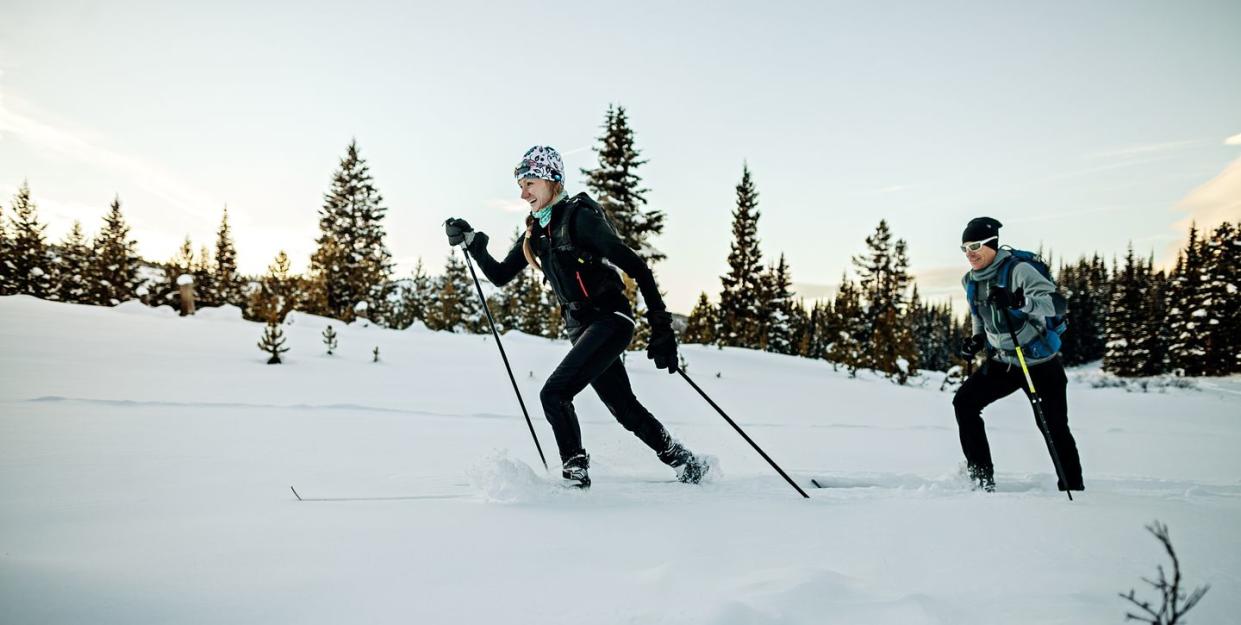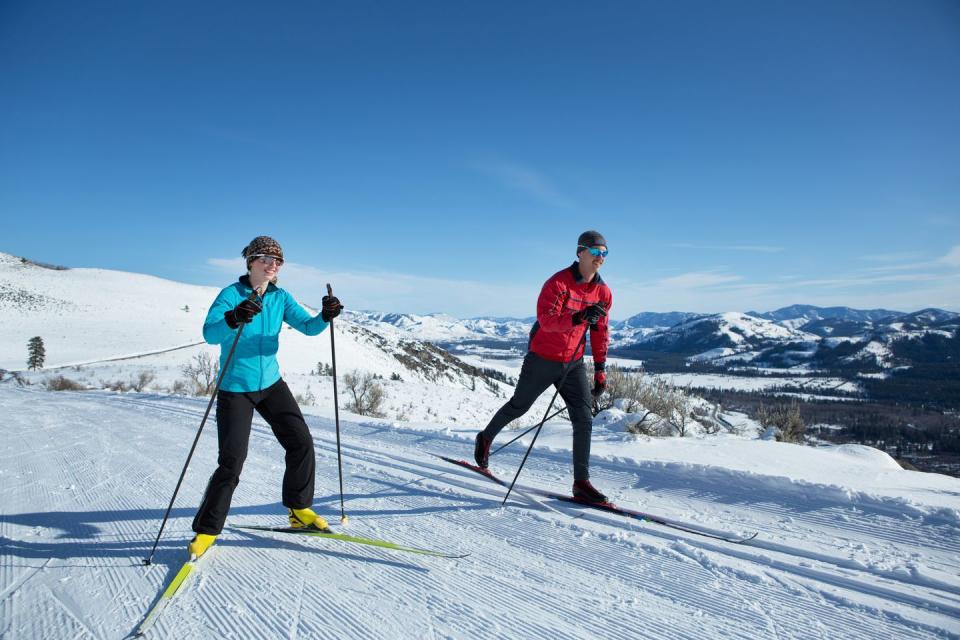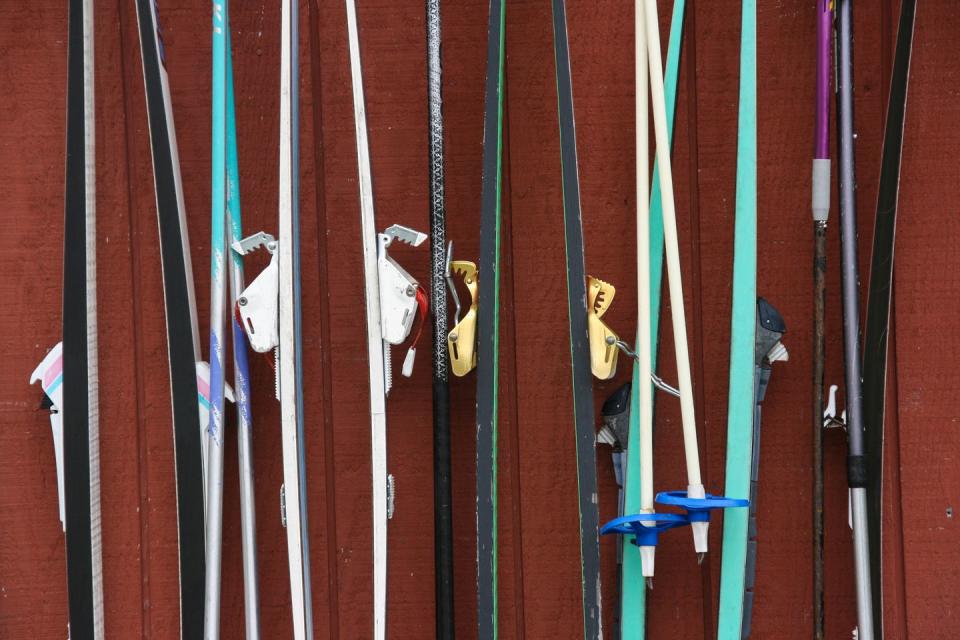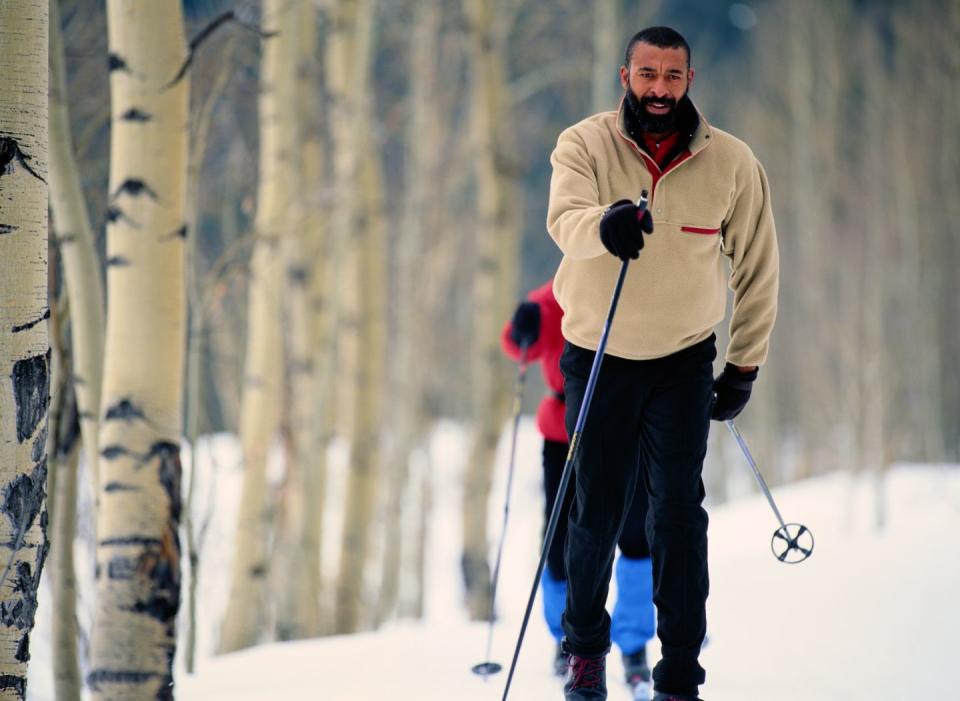Cross-Country Skiing Is the Perfect Cross-Training for Cyclists—Here's How to Get Started

"Hearst Magazines and Yahoo may earn commission or revenue on some items through the links below."
If you’re itching to train outside in the winter, or you just need a break from riding the trainer, cross-country skiing might just be the perfect cross-training activity to boost your overall endurance while targeting every major muscle group in your body.
From Olympic bronze medalist Catharine Pendrel to former WorldTour racer turned gravel cyclist Alexey Vermeulen, plenty of pro cyclists swap their bike for skis in the winter for some alternative outdoor training. Mountain biker Katerina Nash has been to the Olympics for both cross-country skiing and mountain biking on multiple occasions, as has Paralympian Oksana Masters for both cross-country skiing and handcycling.
In fact, research has shown that cross-country skiing is more efficient for improving VO2 max and boosting energy expenditure than indoor cycling.
“I think it helps me as an athlete and as a person,” says Canadian mountain bike national champion Jenn Jackson. “It gives life seasonality and variety. And it helps with general athleticism: It forces you to do a dynamic range of motion and to move on multiple planes. It gives you so much functional strength and coordination. I think the return on investment for an hour-long ski is much better than going for like a two- to three-hour ride.”
“For me, the winter is a good time to get away from the bike. The fitness that’s provided from cross-country skiing is the best, because it’s total body. But at the same time, it doesn’t have the pounding that comes from running,” says Scott Horn, a cross-country ski coach at JH Nordic in Jackson Hole, Wyoming, and a longtime cyclist.
Convinced? Good. Let’s talk about why cross-country skiing works, and how you can try it yourself. And if you’re already a skier, read on: The coaches and athletes we talked to have some great advice for beginners and advanced skiers alike.
The Different Cross-Country Skiing Techniques
Cross-country skiing, a.k.a. Nordic skiing, is broken down into two categories: classic and skate skiing. The classic style involves skiing in a relatively straight line with a technique called “diagonal stride”—it’s a motion that’s comparable to running, but it can also involve just using your poles to propel you forward. Skate skiing is just as it sounds, with a side-to-side gliding motion that’s similar to ice skating or rollerskating. (Salomon offers a great description of classic versus skate skiing if you’re still not sure which is which.)
“Classic skiing is great because it can be enjoyed pretty quickly, without a lot of instruction,” says Horn. “That stride movement is pretty self-explanatory—you’re gliding forward in a straight line. But with skate skiing, if you want to truly be skiing, rather than just shuffling, it takes some instruction and practice. If someone tells me that they just want to ski a few times in the winter, I suggest trying classic skiing with rental equipment.”

Cross-Country Skiing Equipment
You’ll need skis, boots, and poles to get out on your first cross-country ski. (And no, your downhill skis will definitely not work here!)
Rent first if you’re not sure about this whole cross-training thing. Don’t buy cheap equipment or used equipment and simply hope for the best: You’re better off borrowing first, then investing in skis that are the right size and style for you, says Yuriy Gusev, executive director for the Central Cross Country Ski Association and former pro skier and coach.
“As with bicycles, where you have different tires, frame materials, and components, skis have different sizes, styles, materials, and fits,” Gusev says. “Find a ski shop that will help you find the right equipment for you.”
(Check out REI’s guide to cross-country skis to learn more about the different styles.)

Cross-Country Skiing Tips
Invest in Instruction
If you live near a Nordic center that has lessons, it’s worth the initial spend to learn good habits on the skis—you’ll potentially save yourself years of grief by using the correct techniques from the start.
“Don’t mess around, just get a lesson instead of being frustrated. I would suggest a one-on-one session instead of a group session if you can afford it,” says Gusev. “You won’t need many. Five lessons and you should have the technique figured out, and you’ll be able to have a lot more fun right away.”
Don’t have time or money for lessons? “Ski with someone who knows what they’re doing,” says Jackson. “Try to emulate them. It’s a great way to learn. In skiing, there are some nuances with timing that are difficult to explain, but if you just try to follow someone on the skis, it’s easier to pick up.”
Don’t Go Too Long
On any given weekend bike ride, you might decide to be out for several hours. But cross-country skiing is more closely related to running in terms of how long you can comfortably exert yourself.
For most beginner cross-country skiers, an hour is going to be a tough workout! You’re incorporating all the major muscle groups, so you’re likely going to tire out much quicker. And the newer you are, the less efficient you’re liable to be, so you’ll be working hard even when you’re skiing at a walking pace.
“I love skiing because it’s easy to be very bad at it. You have a good workout no matter how the day goes,” says Vermeulen. “I can go out and do an hour and a half of skiing and feel like I would after a five-hour ride. Sometimes, I’ll even do a trainer ride and finish with a short cross-country ski to get outside.”
Get Used to the Glide
Cyclists might initially struggle with the gliding component of cross-country skiing, where weight is transferred from one leg to the other in order to glide forward.
“Growing up, it was my job to varnish these wooden floors in our house, and when I was done, the first thing I would do is throw my socks on and go glide across that wooden floor: That’s the feeling we’re trying to get on the ski, that freedom,” says Horn.
Horn’s advice for those trying to learn this new motion is this: “shuffle, shuffle, glide.”
“Rather than trying to take full glides on each ski, just do a little bit of shuffle, then take your one glide, and then shuffle, shuffle, glide,” he says. “Ultimately, if you’re a good cross-country skier, you are transferring 100 percent of your body weight over one ski, and then going and transferring it to the other ski. For those who are not very good skiers, their weight is [distributed] between the skis.”
Home Workout Essentials
“Tony Knows”
Need a visualization to dial in your alignment? Think “Tony knows,” as in: toe, knee, nose. “Your toe, your knee, and your nose should be aligned over the one ski as you glide,” says Horn. “You can also think about getting your belly button over the one ski.”
He suggests practicing this everyday, outside of skiing. Anytime you’re brushing your teeth, look in the mirror and balance on one leg with your knee and nose over your toes, then switch legs. This helps you learn to transfer that weight from one leg to the other leg.
Not only will this help your skiing, it actually has a cycling side-benefit as well: In cycling, when you’re going into a tight corner, your outside foot should be down. This is not just to avoid clipping a curb, you should also be pushing into that outside foot and transferring your weight to that foot in order to stabilize yourself. (That’s right, cross-country skiing can help improve your cornering on the bike!)
Add in Upper Body Work
A big benefit of cross-country skiing is that it’s a full-body workout. Your core and arms get into the mix as well, if you’re using your poles effectively. “With classic skiing, think about throwing a softball,” Horn says. “It should come from the shoulders, not the triceps.” Unless you’re double poling—using both arms at the same time—you should be swinging your arms in the same rhythm you’d swing them while running.

Dress Warm—But Not Too Warm
You will warm up quickly when you’re cross-country skiing, but you may also end up standing still (or lying in a snowbank) for chunks of time, so dressing appropriately becomes a challenge. Dress similar to how you would dress for fat biking or winter running, instead of how you would dress for downhill skiing. You need to be able to move easily, without a lot of added bulk.
“Look for breathable fabrics and clothing,” says Gusev. “You don’t want to get sweaty and feel like you’re in a plastic bag.”
Don’t Neglect Fueling
As with any activity over an hour, if you’re going for a longer ski, you’ll want to bring a snack and a water bottle or hydration pack with you. “A lot of people will use hydration packs or just a belt that can fit a water bottle,” says Gusev. Just be careful that if you do use a pack, keep your hose tucked inside your jacket so it doesn’t freeze.
Learn How to Get Up Again
When you’re cross-country skiing, you will fall over. Luckily, unlike downhill skiing, the crashes tend to be at slower speeds and are more awkward than painful. Typically, when you do fall, you end up on your back with your skis and poles in all different directions.
“The first thing you want to do is be like a dead bug: roll onto your back, get your arms in the air and your legs in the air,” says Horn. “Don’t try to get up when the skis are pointing down the hill or up the hill, because you’re going to just start sliding. Get perpendicular to the hill. Then, roll yourself to one side and slowly crawl the front of your body with your hands up to the front of your skis. And then you can easily lift yourself up.”
Cross-Country Skiing Alternatives
No snow? No problem. Whether you simply live in an area that doesn’t get enough snow (or any) for skiing, or you live in an area where cross-country ski access is only available at Nordic ski centers or during a few weeks out of the year, you may need to supplement your on-snow time with some alternative training to get the same benefits.
If you’re truly serious, roller skis are an investment that allow you to “ski” on a regular road. (Don’t forget to wear a helmet!)
But if you just want similar effects from a workout that isn’t cycling, or extra gliding practice, Horn recommends rollerblading or ice skating. Focus on the gliding motion and weight transfer though, Horn says. It’s easy to “cheat” on rollerblades and skip the balance element.
Gusev adds that walking uphill (with or without poles) is also a great way to prep for cross-country skiing, especially if you hope to do more backcountry skiing on rugged terrain.
You Might Also Like

